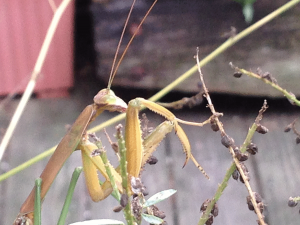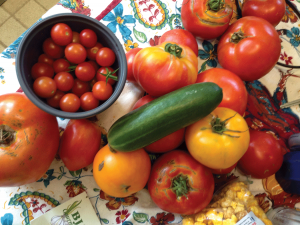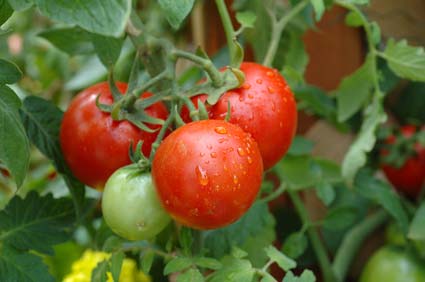 It was a good garden season this year. Appropriate rain in the spring, but then dry, dry, dry all of June, July and the first week of August. But irrigation is both a science and an art, and we kept it all both well fed and well watered, and everything except the cucumbers simply thrived. Except the weeds, which simply didn’t exist this year. There were tomatoes certainly – a dozen different kinds, green and yellow beans, five or six kinds of summer squash, and lots of both the big green sweets and the way-too-hot-to-even-consider peppers. We’ve been eating high off the (vegetable) hog since mid-June.
It was a good garden season this year. Appropriate rain in the spring, but then dry, dry, dry all of June, July and the first week of August. But irrigation is both a science and an art, and we kept it all both well fed and well watered, and everything except the cucumbers simply thrived. Except the weeds, which simply didn’t exist this year. There were tomatoes certainly – a dozen different kinds, green and yellow beans, five or six kinds of summer squash, and lots of both the big green sweets and the way-too-hot-to-even-consider peppers. We’ve been eating high off the (vegetable) hog since mid-June.
In early August the faucet was turned back on and the rains returned. Some days lots of it. So some days you didn’t get to pick and somedays you picked a lot. It was one of those pick a lot days, after supper one humid, hazy, cloudy, damp mid-August evening while reaching for a ripe, juicy, very red and ready globe buried down and beneath a plant grown to Redwood status, with multiple stems, and intertwined branches with branches with more branches all bearing fruit, that I inadvertently grabbed a Praying Mantis rather than the tomato I was reaching for. I was, as you can imagine immediately told in no uncertain terms that messing with a Mantid was not a good thing to do.
 Back when I was growing tomatoes, squash, corn, eggplant, pumpkins, apples, cukes, peppers, asparagus and rhubarb for a living there was an unwritten rule about tomatoes. If you didn’t have ripe tomatoes (and sweet corn) by July 4th, and if a tomato plant (or pepper plant) didn’t produce a bushel of tomatoes (or peppers) by season’s end you simply weren’t good enough to be called a grower. You were a picker maybe, but not a grower. Back in the day pickers were just plant havers, not real farmers. I don’t’ know the metrics anymore but I still apply those measures to our garden. So our plants back then got pretty big. We didn’t stake or cage them or pinch much (removing those rascally extra branches growing out from the leaf axils), and we simply let them sprawl all over. We had lots of room so that wasn’t a problem and picking took a bit more work but we produced a bushel of tomatoes, or more, on every plant, even considering the few that got stepped on or rotted out by lying on the ground.
Back when I was growing tomatoes, squash, corn, eggplant, pumpkins, apples, cukes, peppers, asparagus and rhubarb for a living there was an unwritten rule about tomatoes. If you didn’t have ripe tomatoes (and sweet corn) by July 4th, and if a tomato plant (or pepper plant) didn’t produce a bushel of tomatoes (or peppers) by season’s end you simply weren’t good enough to be called a grower. You were a picker maybe, but not a grower. Back in the day pickers were just plant havers, not real farmers. I don’t’ know the metrics anymore but I still apply those measures to our garden. So our plants back then got pretty big. We didn’t stake or cage them or pinch much (removing those rascally extra branches growing out from the leaf axils), and we simply let them sprawl all over. We had lots of room so that wasn’t a problem and picking took a bit more work but we produced a bushel of tomatoes, or more, on every plant, even considering the few that got stepped on or rotted out by lying on the ground.
That was then. We don’t have that kind of room now, or at least we don’t take that kind of room now because we don’t have the tractors, cultivators and crew to do that kind of work, so we squeeze things together a lot, and we don’t plow or cultivate much, just rototill a row and put the plants in the row, a cage around the plants when they are small, and drive in and fasten a good sized stake to hold the cage for extra support. Then we cover it all with a layer of cardboard and inches and inches of straw. We still don’t pinch too many suckers when they form, so the plants get pretty big and because they are in that cage they can get really squeezed. I don’t think you could a drive car, well, a small car through our garden because of the huge plants, the tomato cages that try to hold them and the stakes that hold the cages and the squash and cucumber vines tangling everything together. This makes for less work managing the plants during the season, even with the few insect pests we get and the occasional outbreak of fungal or bacterial problems that happen sometimes because everything is so crowded, but the dry year worked to our advantage there. And it does make more work picking them as the fruit ripens. But there’s lots more fruit to pick because there’s more branches that produce blossoms. It’s a time, space, production balancing act. It works.
So it can be an adventure when you go to pick tomatoes because the fruit gets buried under a ton of foliage and you have to lift and pry and shove stems and branches and leaves aside so you can see what’s at the bottom of the plant. And there’s always, always two or 10 just ripe and ready to pick tomatoes down there waiting for freedom. Often they get wedged between two or more stems and you have to argue with the stems, the stake, the cage and other tomatoes, while those leaves above are in your face. And sometimes you can see the tomato way down there, but you have to kind of twist and turn and wend your way down to it without really seeing where your hand is going. That’s when it gets interesting. Sometimes there are other things down there besides tomatoes. Praying Mantids, for instance.
As I pushed my hand toward that nearly out-of-reach perfectly ripe tomato, I had to grab and move a very thick branch. The Mantid was hanging onto the underside of the branch and I grabbed the two together. The Mantid  lunged out toward my hand, striking the side of my hand just below my little finger – where it’s kind of tender. Immediately I thought I’d been stung by a – yellow jacket, bumblebee, honey bee – something – because the pain was sharp, intense and immediate. But as I very quickly backed out of that tomato plant, the pain had essentially disappeared by the time I got back on my knees. I looked at where the wound should be, but there wasn’t a mark to be seen. I bent over again and looked into the crater I’d created trying to reach that perfectly perfect tomato and there, looking up at me with a snarl, front legs waving like a boxer, head twisting and turning, antennae swirling, rear legs stomping on the stem just daring me to try that again, was this beautiful, menacing, dangerous Mantid. See that spine on its front leg? I got stuck with that when it struck out at me at what felt like about 100 pounds/sq in pressure. But it wasn’t quite that hard. It didn’t even break the skin.
lunged out toward my hand, striking the side of my hand just below my little finger – where it’s kind of tender. Immediately I thought I’d been stung by a – yellow jacket, bumblebee, honey bee – something – because the pain was sharp, intense and immediate. But as I very quickly backed out of that tomato plant, the pain had essentially disappeared by the time I got back on my knees. I looked at where the wound should be, but there wasn’t a mark to be seen. I bent over again and looked into the crater I’d created trying to reach that perfectly perfect tomato and there, looking up at me with a snarl, front legs waving like a boxer, head twisting and turning, antennae swirling, rear legs stomping on the stem just daring me to try that again, was this beautiful, menacing, dangerous Mantid. See that spine on its front leg? I got stuck with that when it struck out at me at what felt like about 100 pounds/sq in pressure. But it wasn’t quite that hard. It didn’t even break the skin.
I looked around, and just beneath the branch it was standing on were about 50 or so what appeared to be immature Brown Marmorated stink bugs, all lustfully sucking away on a tomato even further down that I hadn’t seen. The Mantid was stalking them when I so carelessly got in the way I guess. They scattered pretty fast when I moved the stem again, unaware, it seems, how close to being a Mantid’s supper they had been. Ok, so I let the Mantid be a Mantid, and silently urged him/her to keep eating those pesky tomato eating bugs. Everybody has to eat something…whether its tomatoes or stink bugs. I’ll stick to the tomatoes, and let the Mantid stick it to the stink bugs.
•
It was also a good honey season this year. That dry warm weather early on got things going, and the locust flow was outstanding, followed by a terrific basswood crop. I kept them apart so now have some of each sitting in pails waiting to be bottled. When it dried up during the hot part of Summer the clover came on strong and kept things going when nothing else was producing, and late Summer produced a good, but not great, crop of golden honey plant and goldenrod for overwintering. I got a formic treatment in there in late Summer and the mite population looks mighty low – can’t find any in a couple of hives after multiple alcohol washes and fewer than two in the rest – with one exception.
There’s that nuc that kept throwing queens all Summer. I had, I think, about six or so in there in the last five months and none of them stayed. Queenless, queenless, queenless, all Summer long. I’d introduce a queen in a cage, leave her there for a week or 10 days, things looked fine, everybody happy, release here and she’s gone in less than a week. Lots of brood, then some brood, then no queen. Try, try again. After paying for a couple I said, OK, you don’t like mine, raise your own. And they put out queen cells to die for. Lots, every time. And, to change the mix, I always added a frame with eggs from another hive to mess with the genetics of what got raised. And they made cells from that too. And then they tore them all down – either just before they emerged, or right after the new queen emerged and they killed her, too. Either way, no queen again. This colony had a death wish.
So then I tested for mites again, just to see. And guess who had a boatload. Now, because egg laying and brood rearing were spotty all summer, I’m guessing there were more mites outside of cells than in them, which is the reverse of normal. But 12 mites? Really?
So. Now the real world of the ‘organism is the beeyard’ comes home. Do as I say, or what?
When that queenless colony finally crashes in, say late September or early October because there’s no brood to speak of, there’s lots of mites with nowhere to go but on adults, and deformed wing started to be seen in late August in that, and only that colony, what, do you suppose, will happen? Those bees will leave home just as fast as they can get out of Dodge and go – where? They’ll find a home in any of the 10 other colonies within 50 yards of where they take off from. In fact, all but one is visible from the front door of that queenless wreck.
So, just treat the down and outter? Or treat them all so when it crashes and the bees (and the mites they take with them) are all exposed to the same treatment in every colony, no matter where they go and that’s it for the mites. Or, just treat the one?
This is when you’d like to have a dozen beeyards so you could try a few things like this. It’s expensive to treat everybody. And it’s not healthy to be introducing any kind of poison into a box full of bees.
There’s one other option. Isolation. Pick that sick sucker up and move it a bunch of miles away and treat just that colony, and leave the rest alone since they all seem to be doing fine. That’s the best option I think, if it is an option. I’ll let you know how it turns out . . .
•
One thing that the above situation brings up is developing bees that get along with the mites. Call it resistance, ankle biters, Russians, local, feral, whatever, there are bees that deal with the mites pretty well. A bunch of groups in several states have formed consortiums that share stock, test each other’s stock, work with outsiders who also have bees that seem to deal with this. They bring in known resistant/tough/hardy/whatever you want to call them stock from Universities and breeders, mix them with what they’ve found and keep narrowing down their stock, narrowing it down, down to something that stays alive. Or mostly stays alive.
Finding these producers is one thing. Finding producers that still have queens in June is another thing, but if you start now, you can find sources that will, and you’ll be set. But here’s the question. There’s a group in the Ohio/Indiana/West Virginia region that does this, and I suspect they’d be pretty well adapted to northern Ohio. Pretty well. West Virginia Winters and Cleveland Winters tend toward being just a tad different. But I urge you to take a look at our mailbox this month for a bit of information of just one of these groups. We need more of them. And we need our commercial producers to be doing the same thing.
•
As you read this we’re putting the finishing touches on our A Case For Honey conference at the end of the month. If I do say so we have a great line-up of speakers going. The National Honey Board will be here – they got their schedule rearranged and Margaret Lombard, the CEO can make it, and we have an Ohio Dept of Ag person – Joann Dunlevy – who will address all the new Food Safety regs heading our way. Then we have beekeepers by the score. Gene McCune, from right here in Ohio, will talk about gearing up and getting his honey house up to speed now that he’s retired and expanding, Dan Conlon, who also raises Russian Queens and sells honey in Massachusetts will talk about that balance, Dave Shenefield, the biggest beekeeper in Indiana, has a mix of honey packing, pollination and honey making information. Then Bob Binnie, from Northern Georgia talks about marketing, his experience with retail and wholesale and making varietal honey, and not last, and not least is Roger Starks, from Howlett McDowell Insurance, who knows more about risk management, the new FDA regulations and insurance issues in the beekeeping industry than anybody I know. Finally Collin Stone and Geoff Martinak, from Canada, will be talking about going from hobby to commercial in only three years, and the Extractor Trailer they have that is a complete unit going from beeyard to beeyard – supers in one end, barrels of honey out the other – it’s an amazing operation, and if we’re lucky one of their units will be in the parking lot to examine. If growing your business is in the future for you, this is a program you will want to experience. There’s still time, and there’s still room and it’s worth every minute and every penny. Come on down . . .
•
We’ve done a few of these events now – Miles To Go, on migratory beekeeping, The Russians Are Coming, on Russian bees, 4 Pillars on nutrition, Varroa, Winter and honey production, and now A Case For Honey, for those who want to expand their honey business. And, we already have next year’s planned – well, sort of scoped out as to what we’d like to do.
So – you’ve taken the beginner’s class and been at this awhile, lost some but not many, don’t have a ton of time, make some of the meetings, but just want to get better at what you’re doing. Not grow the business, just keep them alive. Your smoker stays lit, you know which end of the hive tool to use and you almost always remember to zip the hood on your beesuit all the way closed. So what’s next . . . Well, simply, The Next Class. You’re no longer a beginner, but keeping bees alive isn’t all that easy, and maybe raising a few queens once in a while would be good, and what about making some of your own equipment, or raising some of your own bee pasture, or moving a few bees for pollination, or wintering indoors for a change, or making sure you can ID every problem your bees have, maybe selling some nucs so you get rid of those extra bees, actually make some money and stop swarming at the same time, or not selling more honey but selling what you have for more money, or making something with wax, or propolis, or even bee venom, or, well, I think you get the point. It’s not about getting bigger, but getting better. That’s what you want to do. And now you can.
Next year, in Bee Culture’s Conference Center, there will be not one, but two sessions of The Next Class. The first, for Spring and Summer, and the second, for Fall and Winter, and we’ll cover, we hope to cover anyway, all those topics just listed and more, at the speed, and the scale you want them covered. Getting Better, Not Bigger. That’s the goal next year. Stay tuned for more as this unfolds. I think you’ll like what you see.
•
In the New Products section we have a review of a book about water. Nothing to do with bees, other than they need it as much as we do, but it’s simply about the state of water in the world. I worry about water, or actually not having enough water. And why in a beekeeping magazine does this matter? Let me give you some numbers that may explain this.
There are 683 million people that still obtain all of their water from an open, unimproved drinking water source. Half of those are in Africa.
Water for food . . . A western diet requires about 925 gallons of water a day to produce. To produce a single pound of these foods, requires. . .
Beef – 490 gallons (that means it takes 123 gallons to make a quarter pounder – more if you have cheese with that), chicken – 150 gallons, rice – 80 gallons, bread – 50 gallons, apples – 26 gallons, and tomatoes – seven gallons of water. That’s right about seven gallons of water for just one of my Mortgage Lifter Tomatoes being eaten by those stink bugs this summer. And almost all of that I had to apply. Seven Gallons.
One quote made all this crystal clear. Our industrial lifestyle is propped up by water even more than it is propped up by oil.
It’s available from University Of California Press.
•
Somebody asked me the other day how much room he would need to store about 100 deeps, crossed ways so the wax moth wouldn’t get into them too bad, in a room with only an eight foot ceiling. Well, it’s a math thing and you can figure it out, but it got me to thinking – it’s October, and I have to rearrange the garage again to accommodate the supers I had last year, plus what I got this year. But I don’t have any more garage to put them in. It’s kind of a good problem to have, but it’s still a problem. I can’t put them in the chicken coop, I don’t have a storage shed, and the basement just doesn’t do it. Maybe outside this year. What could go wrong?







